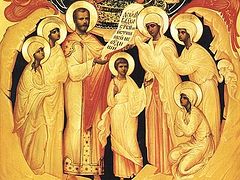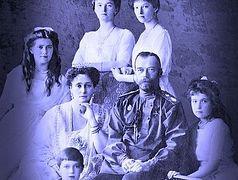101 years ago, on the night of July 4/17, 1918 in Ekaterinburg, the Royal Passion-Bearers and their loyal servants were shot. This sacrifice was the culmination of the tragedy experienced by the Russian people in the years of the revolutionary turmoil. The holy Emperor Nicholas II was doomed to death after he was deprived of legal authority: The death of deposed monarchs, even if deferred for a time, is an historical rule, not an accident. The famous executions of the British King Charles I and King Louis XVI of France together with his wife Marie Antoinette are textbook examples.
The martyric death of the crowned Passion-Bearers in the basement of the Ipatiev House was the second act of the tragedy that began in March 1917, when the generals who betrayed their oath, acting in concert with the Duma leaders M. V. Rodzianko, A. I. Guchkov, P. N. Milyukov, and A. F. Kerensky, who previously did not hide their aspirations to change the governmental system (to replace the autocracy with representative rule in the form of a constitutional monarchy or direct parliamentary republic) forced the emperor, the supreme leader of the Russian armed forces, to abdicate the throne in the midst of the great war [World War I]. Some generals—M. V. Alekseev, N. V. Ruzsky, A. M. Krymov—were directly involved in the plot to dethrone the Tsar; other commanders—the Commanders-in-Chief of the front Grand Duke Nikolai Nikolaevich, A. A. Brusilov, N. I. Evert, A. V. Sakharov, and the Commander-in-Chief of the Baltic fleet A. I. Nepenin—supported the conspirators’ criminal initiative in their telegrams and called for abdication; the Commander-in-Chief of the Black Sea fleet A. I. Kolchak washed his hands of it and didn’t answer the question about his attitude to the prospective abdication of the emperor in the telegram sent him from central command.
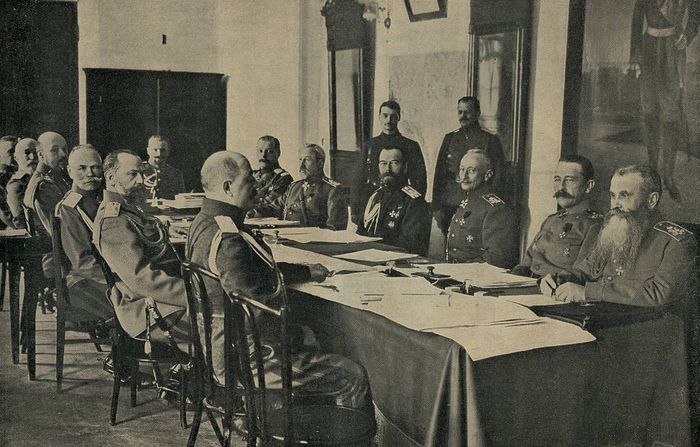 Meeting of the Military Council on April 1, 1916 under the chairmanship of the Emperor
Meeting of the Military Council on April 1, 1916 under the chairmanship of the Emperor
Among the generals who betrayed the emperor was L. G. Kornilov. Having accepted the post of Commander-in-Chief of the Petrograd military district from the self-proclaimed provisional government on March 2, 1917, in the midst of a military revolt, instead of taking measures to suppress the revolt he arrested the holy Empress Alexandra Feodorovna and her children and then held them in custody in the Tsarskoe Selo Palace. Meanwhile, the military revolt in the capital, under the pretext of which the coup was committed, did not release the commanders from their oath, by virtue of which they were obliged to fulfill their duty of loyalty to the Tsar with particular zeal in such difficult circumstances.
In justification of their oath-breaking, these generals later claimed that they were moved to eliminate Nicholas II by their concern that the Russian army continue the war with Germany and its allies, and that, insisting upon his abdication, they were trying to prevent the defeat of Russia. Perhaps that’s what they thought at the time. But they still failed to prevent the capitulatory Brest-Litovsk Treaty. The overthrow of the Tsar only accelerated the collapse of the Russian state machine and the Russian army, and the betrayal committed by them remains a crime of colossal scale in its consequences.
The blood of the Royal Passion-Bearers therefore lies upon the conscience not only of the political actors who decided to kill them in Moscow and in Ekaterinburg 101 years ago, but also the military leaders who betrayed their supreme commander, to whom they swore allegiance and whose charity they collected. Their betrayal was the first act in the assassination of the anointed of God. Therefore, let us name Grand Duke Nikolai Nikolaevich, Generals Alekseev, Ruzsky, Krymov, Evert, Sakharov, Brusilov, and Kornilov, and Admirals Nepenin and Kolchak on par with Lenin, Sverdlov, Trotsky, Goloschekin, Beloborodov, and Voikov.
No sin is left without retribution. The final triumph of Divine justice will take place at the final and dread judgment. The posthumous fate of a man who has departed for the other world is determined provisionally by the judgment of God after his death, and a veil of mystery lies over this judgment. But for the edification and warning of those living on earth, the Lord often shows in a visible manner the sad consequences of criminal acts in the earthly fate of sinners.
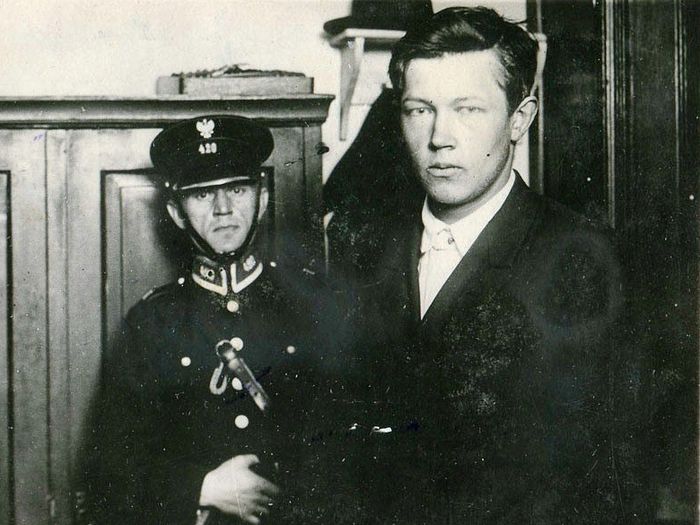 Questioning of Boris Caverda at the railroad police post after the murder
Questioning of Boris Caverda at the railroad police post after the murder
Let’s look at the end of the lives of the direct political assassins of the Royal Passion-Bearers. A key role in the Ekaterinburg Council adopting a resolution on killing the crowned family was played by the local Bolshevik leaders F. I. Goloschekin, A. G. Beloborodov, and P. L. Voikov. Goloschekin, who, besides killing the Royal Passion-Bearers, became famous as the perpetrator of mass starvation in Kazakhstan, where he headed the Bolshevik party organization in the early 1930s, was shot as an enemy of the people, which is quite just, on October 28, 1941. He was rehabilitated under the rule of Nikita Khrushchev, which was not just.
A. G. Beloborodov, an executioner not only of the Royal Family, but also of the Don Cossacks, once held the touching post of chairman of the Commission for the Improvement of Children’s Lives, but was excluded from the All-Union Communist Party (Bolsheviks) in 1927 and was sent into exile in Archangelsk as a Trotskyite. He was shot on February 10, 1938. In 1958, this executioner was also rehabilitated, and four years later was posthumously restored to his native party—a kind of faith in the afterlife was, it turns out, not foreign to the communists of the Khrushchev thaw.
P. L. Voikov was killed in Warsaw, where he served as Soviet ambassador, on June 7, 1927 by the Russian emigrant Boris Koverda. A Polish court sentenced Koverda to life imprisonment, though he was released from prison after ten years.
From the Kremlin, direct instructions on the massacre of the Royal Family came from the head of the Soviet government, the Chairman of the All-Russian Central Executive Committee (ACEC) Y. M. Sverdlov, the initiator of the ACEC’s resolution on September 2, 1918 “on the red terror.” According to official information, Sverdlov died of the Spanish flu—as it was called then—on March 16, 1919 at the age of thirty-three. But at that time, a rumor spread that his death was the result of a beating he suffered in Orel during a speech at a workers’ meeting. Dissatisfied with the policies of the Soviet leadership, the local proletarians attacked the speaker, and one of them beat his head in. According to the rumor, reflected in the historical literature, this fact was hidden because it called into question the propagandistic thesis that the Soviet authorities carried out the dictatorship of the proletariat. Sverdlov previously agreed on the decision to kill the Tsar together with the Tsarina and their children with Lenin, whose biography and end are known to the world and require no clarification.
In the discussion of the lot of the Royal prisoners, of the highest political leadership of the country it seems only L. D. Trotsky took part, besides Lenin and Sverdlov. The fact is that the decision to murder was taken in Moscow unofficially, off the record, and therefore the circumstances of its adoption are not fully understood to this day. There is reason to believe Trotsky’s later assurances that he objected to the execution of the Royal prisoners by a formal decision of the local Ekaterinburg authorities, proposing instead to arrange a high-profile trial in the capital and act as prosecutor at it. Judging by his character and inclinations, he really could regret that there was no long spectacle where he shone with his eloquence before reporters from around the world. In any case, he didn’t provide for any outcome of the process for the holy Tsar Nicholas II other than a death sentence. Trotsky suffered defeat in the struggle for the leadership in 1923. In 1926, he was removed from the main headquarters of the ruling party—the politburo Central Committee of the All-Union Communist Party (Bolsheviks), in 1927 was stripped of all posts and sent into exile, and in 1929 was expelled from the country. On August 20, 1940, he was mortally wounded by the Spanish communist R. Mercader in Mexico City, where he led the Fourth International that he created in exile, and died the next day.
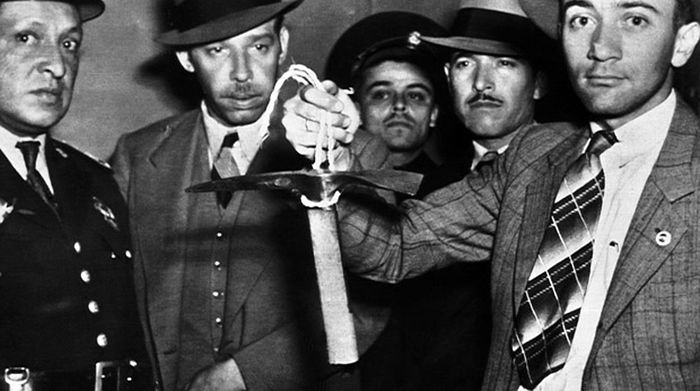 Mexican police with an ice pick. 1940
Mexican police with an ice pick. 1940
Now about the death of the highest military commanders who betrayed the Sovereign: On January 5, 1929, Grand Duke Nikolai Nikolaevich died at his own villa in the French resort town of Antibes. On March 17, 1926, the General of the Cavalry A. A. Brusilov died in his bed at the time that he held the post of Chief Inspector of the Cavalry of the Workers’ and Peasants’ Red Army. The General of the Infantry M. V. Alekseev died on October 8, 1918 in Ekaterinburg, where he took measures to organize an armed resistance against the Bolsheviks, leading the Volunteer Army after the death of Kornilov.
Vice-Admiral A. I. Nepenin was the first of the top military commanders to fall victim to the revolution in which he himself was involved, having spoken out for the abdication of Nicholas II in a telegram sent to central command. On March 4, 1917, he was shot in the back in Helsingfors (Helsinki) on his way to a revolutionary meeting, where he was forced to go by drunken sailors—“the beauty and pride of the revolution,” as Trotsky put it. Major-General A. M. Krymov, who in his disastrous speech supported Kornilov, at that time Supreme Commander, killed himself on August 31, 1917 while leaving the office of Prime Minister A. F. Kerensky, who subjected him to a humiliating interrogation about the “Kornilov Putsch.”
Himself the General of the Infantry, L. G. Kornilov was killed March 31 (April 13), 1918 during the storming of Ekaterinodar by the troops of the Voluntary Army, which he then commanded. Admiral A. V. Kolchak, who proclaimed himself the supreme ruler of Russia, having been defeated in the civil war with the Bolsheviks, was handed over to local authorities by command of the Czechoslovakian corps and was shot on February 7, 1920 by order of the Irkutsk Military-Revolutionary Committee.
General of the Infantry N. V. Ruzsky was living in retirement in Pyatigorsk. After the occupation of the city by the Red Army, he was taken hostage and shot on October 19, 1918. General of the Infantry N. I. Evert was arrested the first time in Moscow on February 14, 1918. He was briefly imprisoned, but on October 20, shortly after the announcement of the Red Terror, he was arrested again and held in prison in Mozhaisk. On November 12, 1918, he was shot during transfer from Mozhaisk to Moscow, according to the official announcement, “in an attempt to escape.” General of the Cavalry V. V. Sakharov was shot by “green” bandits in Crimea in Karasubazar (now Belogorsk) in August 1920.
Touch not Mine anointed (Ps. 104:15), says the Lord, warning those daring to encroach upon the power of the God-appointed rulers. The tragic fate of those who encroached upon the legitimate authority, and then on the life of the holy Emperor Nicholas II, is evidence of the immutability of this commandment.

